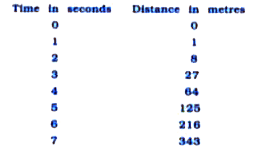Two objects of mass 1 kg and 0.5 kg are moving on linear path with velocity 4 ms−1 and 2 ms−1 in the same direction respectively collide with each other. After collision, velocity of first object is 3ms−1 in the same direction. Find out the velocity of the second object. Solution in Gujrati
4 ms−1
Topper's Solved these Questions
- BOOK - KUMAR PRAKASHANCHAPTER - FORCE AND LAWS OF MOTIONEXERCISE - Question based on pracctical skill with answers(Select the appropriate option and complete the sentence :)4videos
FORCE AND LAWS OF MOTION
- BOOK - KUMAR PRAKASHANCHAPTER - FORCE AND LAWS OF MOTIONEXERCISE - Additional Exercise4videos
FORCE AND LAWS OF MOTION
- BOOK - KUMAR PRAKASHANCHAPTER - GRAVITATIONEXERCISE - ACTIVITY 10.42videos
GRAVITATION
Similar Questions
Newton's II law of motion connects:
04:38View SolutionThe following is the distance-time table of an object in motion:

(a)What conclusion can you draw about the acceleration ?Is it constant. Increasing decreasing ir zero? (b)What do you infer about the force acting on the object?04:29View SolutionTake an empty plastic bottle . Close the mouth of the bottle with an airtight stopper . Put it in a bucket filled with watere . The bottle floats .
Push the bottle into the water. You feel an upward push. Try to push it further down. You will find it difficult to push deeper and deeper. Water exerts a force on the bottle in upward direction. Now release the bottle. It bounces back to the surface.
Does the force due to the gravitational attraction of the earth act on this bottle? If so, why doesn't the bottle stay immersed in water after it is released ?01:04View Solution100g और 200g द्रव्यमान की दो वस्तुएँ एक ही रेखा के अनुदिश एक ही दिशा में 2ms−1और1ms−1 के वेग से गति कर रही हैं | दोनों वस्तुएँ टकरा जाती हैं | टक्कर के पश्चात् प्रथम वस्तु का वेग 1.67ms−1 ही जाता है तो दूसरी वस्तु का वेग ज्ञात करें |
06:04View SolutionTwo objects of masses 100 g and 200 g are moving along the same line and direction with velocities of 2 ms^(-1) and 1 ms^(-1) respectively. They collide and after collection the first object moves at veloctiy 1.67 ms^(-1) determine the velocity of the second object.
04:25View SolutionTwo objects of masses 100 g and 200 g are moving along the same line and direction with velocities of 2 m s-1 and m s-1 respectively. They collide and after the collision, the first object moves at a velocity of 1.67 ms-1. Determine the velocity of second object.
04:25View Solution1 किग्रा द्रव्यमान की एक वस्तु किसी स्थिर वस्तु से प्रत्यास्थ टक्कर करने के बाद, उसी दिशा में एक चौथाई वेग से गति करती है तो दूसरी वस्तु का द्रव्यमान होगा
05:01View SolutionTwo perfectly elastic spheres of masses 2 kg and 3 kg moving in opposite directions with velocities 8ms−1and6ms−1 respectively collide with each other. Find their velocities after the impact.
View SolutionTwo perfectly elastic spheres of masses 2 kg and 3 kg moving in opposite directions with velocities 8 ms^(-1) and 6 ms^(-1) respectively collide with each other. Find their velocities after the impact.
03:20View Solution2 kg এবং 4 kg ভরের দুটি বস্তু একই সরলরেখা বরাবর এবং একই অভিমুখে যথাক্রমে 6 m/s এবং 3 m/s বেগে গতিশীল। তারা পরস্পর সংঘর্ষে লিপ্ত হল এবং সংঘর্ষের পর প্রথম বস্তুর বেগ 2m/s হলে দ্বিতীয় বস্তুর বেগ নির্ণয় করাে ।
02:41View SolutionA 10 kg object collides with a stationary 5 kg object and after collision, they stick together and move forward with velocity 4ms−1. What is the velocity with which the 10 kg object hits the second one ?
03:07View SolutionAn object of mass 80 kg moving with velocity 2ms^(-1) hit by collides with another object of mass 20 kg moving with velocity 4 ms ^(-1) Find the loss of energy assuming a perfectly, inelastic collision
02:30View SolutionAn object of mass 80 kg moving with velocity 2ms−1 hit by collides with another object of mass 20 kg moving with velocity 4ms−1 Find the loss of energy assuming a perfectly, inelastic collision
View SolutionA 10 kg object collides with stationary 5 kg object and after collision they stick together and move forward with velocity 4ms−1. What is the velocity with which the 10 kg object hit the second one ?
04:39View SolutionTwo objects of masses 100 and 200 g are moving along the same line and direction with velocities 2 ms^(-1) and 1ms^(-1) respectively. They collide and after collision, the first object moves at a velocity of 1.67 ms^(-1) . Determine the velocity of the second object.
06:30View Solution

